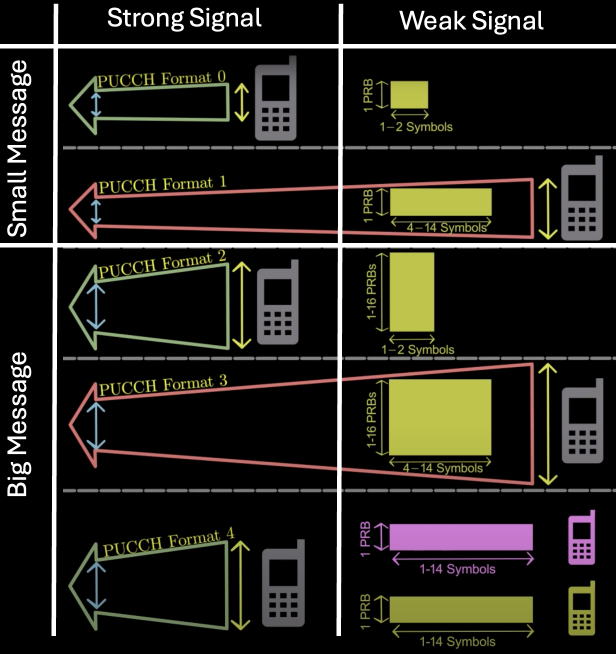Ever wondered how your phone actually acknowledges the messages received from the 5G tower? It’s not just a one-way street! There’s a secret channel called PUCCH (Physical Uplink Control Channel), and it’s how your phone sends control information back to the tower. Let’s break it down without the tech headaches!
Below video helps to dive deep into PUCCH formats:
🔹 PUCCH: Think of it as Your Phone’s Feedback Line to the Network
The 5G tower sends awesome data to your phone. But to keep things running smoothly, the tower needs to hear back. That’s PUCCH! It’s your phone’s dedicated line for giving essential feedback.
What kind of feedback? Think of these key messages your phone sends using PUCCH:
- “Package Delivered!” (ACK/NACK): Did your online order arrive safely? ACK/NACK is like your phone saying “Yep, data arrived perfectly!” (ACK) or “Uh oh, something’s missing, resend please!” (NACK). The network relies on this to know if your downloads are complete and error-free.
- “Can I Speak Now?” (Scheduling Request): Need to send a message, upload a photo, or make a video call? A Scheduling Request is your phone politely saying, “Hey network, can I get permission (resources) to send some data up to you now?” It’s like raising your hand in class!
- “Connection Check-Up!” (Channel Quality Reports – CQI): Is your 5G signal strong and steady? CQI is like your phone sending a quick connection health report: “Signal’s awesome, full bars!” or “Signal’s a bit weak, maybe needs a boost.” This feedback helps the network fine-tune your connection for the best speed possible.
🎯 Network Allocates Resources for PUCCH
The 5G tower is like a smart traffic controller. It decides how much “air time” (network resources) to give your phone’s PUCCH. It’s all about being efficient! The tower considers:
- Signal Strength (Channel Quality): Good signal? Phone’s PUCCH message will be clear even with fewer resources. Weak signal? Network gives PUCCH more resources to ensure the message gets through.
- Message Size: Quick “Got it!” (ACK) needs very little resources. Detailed signal report? Needs a bit more resources.
To handle various signal strengths and message sizes, 5G defines several PUCCH formats, as we will see now.
📊 PUCCH Formats: Different “Speaking Styles” for Different Jobs
Your phone use different PUCCH formats based on signal strength and message size, as illustrated below,

- Formats 0 & 1: Quick “Yes/No” Answers
Designed for lightning-fast responses.- Format 0: Ultra short! Tiny resources! For “blink-of-an-eye” feedback like “ACK – got it!”.
- Format 1: More reliable, but little slow for simple control signals. Good for basic confirmations when signal strength is weak.
- Formats 2 & 3: For Detailed Reports!
For when your phone needs to send more complex info.- Format 2: Uses a bit more “frequency space” for sending larger reports, but keeps it quick in “time.” Great for bigger messages when signal strength is strong.
- Format 3: Goes for more “time” and “frequency space.” Best for bigger messages when signal strength is weak.
- Format 4: The Sharing Superstar! – Many Phones Talk at Once!
- Format 4: Uses a small amount of “frequency space” but utilise a trick called Frequency Division Multiplexing (FDM). This lets multiple phones send their PUCCH messages at the same time using different “slices” of the frequency.
🛠 DMRS: “Decoder Clues” for the 5G Tower! 🚦 (Think of it like subtitles!)

DMRS (Demodulation Reference Signals) are like “decoder clues” or “subtitles” that your phone sends with its PUCCH messages.
(👈🏽 Can you figure out the structure of the cloth only from the orange coloured part? 😉)
Why? Because:
- Wireless signals can get messy! Noise and interference can make signals blurry.
- DMRS help the tower “read” the PUCCH messages perfectly, even if the wireless signal isn’t crystal clear. They are like known reference points that the tower can use to decode the real message accurately.
🔑 PUCCH – The “Must-Know” Bits!
- ✔️ PUCCH = Phone’s Essential Feedback Channel: PUCCH carries vital info like delivery confirmations, requests to send data, and connection quality reports.
- ✔️ Smart Resources: Network gives resources for PUCCH based on signal strength and the size of the PUCCH message – efficient and smart!
- ✔️ PUCCH Formats = Message Styles: Different formats are designed for different types of feedback and signal strengths.
- ✔️ DMRS = Decoder “Subtitles”: Helps the tower understand your phone’s messages perfectly, even if the signal is bit noisy.
Next time you’re enjoying buffer-free video or super-speedy downloads, remember PUCCH is working hard, making sure the network gets your phone’s messages and responds perfectly! 😉

Leave a Reply